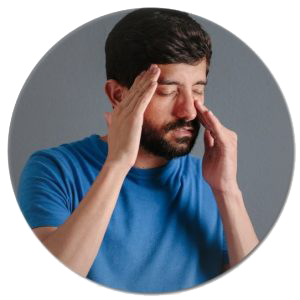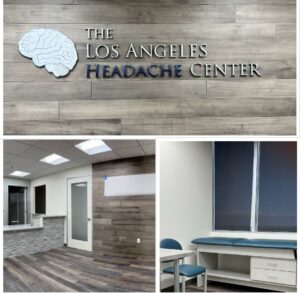Headaches
Chronic headaches, even minor headaches, can interfere with your everyday life and make daily tasks more difficult. Instead of trying to muscle through it or rely on over-the-counter medications that can cause irreversible damage to your liver and kidneys, why not contact the best headache doctor Los Angeles.
If your chronic headaches have become unbearable and you feel like you need to see a licensed Los Angeles headache doctor, contact The LAHC today : 310-277-9534
Reasons for Chronic Headaches

Triggers for headaches can range from bright light to loud noises or even dehydration. It is believed that some headaches are the result of tight muscles, or expanded blood vessels in the head. Other headaches may be caused by an actual problem in the brain, such as a tumor or malformation of the brain, although this is much less common. That’s why it is important to know what is causing your headaches and get proper headache treatment from a licensed Los Angeles neurologist.
Luckily there are highly trained headache doctors that can help you overcome these very painful episodes. Dr. Lisa Cook M.D. has helped thousands of patients overcome chronic headaches, migraines, cognitive disorders, symptoms of CTE, seizures, and a wide variety of other neurological disorders.
Migraines and chronic migraines are a primary headache disorder that is known to cause intense throbbing in one particular area that can vary in intensity. Triggers for migraines can include hormonal changes, certain foods and drinks, stress, and exercise. 50% of migraine sufferers don’t even know they get them, or just think they are bad headaches. Chronic migraines can be caused by different triggers and affect people differently.
If you or a loved one is suffering from a cognitive disorder and are in need of an experienced Los Angeles cognitive disorder specialist, contact The LAHC today : 310-277-9534
Treatment for Chronic Headaches
The first step to treating a headache is to see a Los Angeles headache doctor who can help identify which kind of head pain you are experiencing. If you or a loved one is suffering from Migraines or Headaches, contact Los Angeles neurologist from The LAHC.
Both headaches and migraines cause pain, but being able to fully understand what the difference between the two are will help you better inform your doctor of your symptoms.
There are significant difference between headaches and migraines. A headache is caused by the contraction of muscles between the head and neck. Different types of headaches include cluster headaches, sinus headaches and thunderclap headaches. A migraine, in comparison, tends to range from moderate to very severe throbbing pain at the front or the side of the head. Migraine symptoms may include pain behind the ear, nausea, temporary vision loss and sensitivity to light and sound.
Headache Disorders
Common Migraine (Migraine without Aura)
This is the most common of the migraine headache. 80% of people with migraine experience this type of migraine headache attack. It is characterized by an attack frequency of typically 1-3 times per month but may be more frequent and certainly may be less. It is a moderate to severe headache which may be debilitating precluding the patient from being able to function and work and may confine them to bed until the headache pain and symptoms are lessened. The headache may last from 4-72 hours in duration, shorter sometimes in children and sometimes longer in a few patients. 60% of migraine pain is experienced on one side of the head and 40% of patients have them on both sides or throughout the head. The pain of migraine headache is usually described as throbbing and worsened with movement. Most migraine sufferers prefer to lie quietly and still, not moving and certainly not exerting themselves. Most migraine sufferers experience nausea, some experience vomiting and most will describe sensitivity to light and sound, movement and sometimes odors. A minority of migraine sufferers might experience some numbness or tingling somewhere on their body during the attack. Most migraine sufferers want to be in a quiet, dark place, without commotion or activity around them. They want to sleep if possible. Migraine can awaken the patient in the middle of the night, early in the morning or start at any time. They frequently occur following a stressful event, in response to a trigger such as a food, emotional stimulus either good or bad, weather changes, alcohol, medications and many other factors depending upon the individual.
Classical Migraine (Migraine with Aura)
The Classical migraine attack begins with a visual disturbance referred to as an aura. It is a very dramatic, sometimes colorful display of shimmering lights often compared to the Aurora Borealis (Northern Lights). It usually begins either in the periphery or in the central visual field and migraines slowly outward. It lasts usually 20 to 45 minutes and then dissipates, followed by the headache described above (Common Migraine). Sometimes, patients will experience the Aura without a headache following. This is referred to as Ophthalmic migraine.
Ophthalmic Migraine ( Migraine Aura without Headache)
This is a very dramatic, sometimes colorful display of shimmering lights often compared to the Aurora Borealis (Northern Lights). It usually begins either in the periphery or in the central visual field and migrates slowly outward. It lasts usually 20 to 45 minutes and then dissipates. It can produce a complete obscuration of vision in which the patient must stop doing what they are doing and wait for the visual disturbance to pass because then truly cannot see. Sometimes they may experience an almost complete blindness except for a “rim” of vision around the aura. Some will also describe a sensation of tunnel vision.
Hemiplegic Migraine
This is a migraine headache associated with neurological symptoms similar to stroke. The patient might experience numbness, sensory loss, weakness or paralysis of the face, trunk, arm or leg typically on one side of the body. They might also have speech and language disturbances. The neurological symptoms may come and go throughout the attack or they may last for the duration of the attack. A migraine sufferer who has never experienced this type of migraine and then has one must contact their doctor or go to the nearest emergency room. The most important feature of this condition that establishes the diagnosis of hemiplegic migraine is recurrence of attacks that are stereotypical; that is they occur with the same symptoms followed by resolution each and every time. Otherwise it is important to rule out a stroke or other neurological condition when this occurs for the first time.
Ophthalmoplegic Migraine
This is a migraine attack characterized by dysfunction of the nerves that innervate the eye so symptoms include double vision, closure of the eye lid and of course headache. It may last days or weeks even. This is a very rare condition.
Vertebro-Basilar Migraine
This is a migraine attack characterized by headache associated with symptoms of dysfunction of the brainstem. This might include, behavioral changes, double vision, dizziness, vertigo, loss of vision, alteration in consciousness, inability to balance or walk. It is a rather uncommon form of migraine but one that is important to recognize. A person who is experiencing these type of symptoms for the first time must consult their doctor or go to an emergency room for evaluation.
Tension Type Headache
This is the “garden variety” headache that nearly everyone has experienced at one time or other in their life. It might occur infrequently or frequently. It is a dull to moderate headache that usually involves both sides of the head or is felt throughout the head. It is pressure like, gripping or squeezing in character and not usually associated with nausea or vomiting, light or sound sensitivity. It is uaully responsive to over the counter pain relievers. It might occur in response to hunger, stress, to much or too little sleep, boredom or any number of other factors. Patients with this type of headache usually do not consult a doctor as they occur so infrequently at times or are easily explained by some factor the patient experienced. However, some patients note the increasing frequency and intensity of this type of headache and the frequent nature of this headache might bring them to the doctor for evaluation. When this type of headache occurs more often than 14 days per month it is called Chronic Daily Headache. Evaluation and treatment of this headache disorder is important. Using too much over the counter medications can lead to stomach ulcers, liver damage, kidney damage or bleeding and bruising.
Chronic Daily Headache
This condition is characterized by a frequency of headache which can be mild, moderate or severe, occurring on more than 14 days per month and usually is daily or almost daily. Most patients evolve into this condition sometimes over week, months and most often years. In most cases it is treatable and controllable.
Cluster Headache
There are 2 types of Cluster Headache (CH). Episodic (80%) and Chronic (20%). The headaches are the same in each type. The headache is severe and incapacitating. It is always located on only one side of the head, most often behind the same eye and into the temporal region and sometimes in the back of the head on the same side. The pain is described as constant and boring rather than throbbing. It is frequently unrelenting and lasts usually 30-90 minutes in duration. Although these patients do not usually experience nausea or vomiting, light or sound sensitivity with the headache, they do experience tearing and either nasal stuffiness or watering from the nose also on the side of the headache. During a severe cluster attack the patient is unable sit still or lie down. Rather they tend to feel irritable and either pace around the room, sit in a chair and rock or writhe in pain. The pain of CH is one of the worst described pains in medicine. Episodic CH is characterized by periods of headache during which patients will have 1-3 attacks per day, daily (sometimes more) for 2 weeks to 3 months followed by a remission period of weeks, months or years. Those with chronic CH do not experience the remission periods.
Other Headache Syndromes
The medical literature is replete with headache diagnoses, most of which are variants of those headaches described above. For example there is Post-Traumatic headache which occurs following trauma either to the head or neck and may persist for days, weeks or months and in some cases for years. Paroxysmal Hemicrania is a condition similar to cluster headache but the attack durations are typically shorter and more numerous in a 24 hour period. Hemicrania continua is a constant one sided headache which may be associated with cluster headache like features as well. Trigeminal Neuralgia although not typically a headache disorder is head or facial pain condition characterized by jabs of pain, burning pain, electrical pain shocks and aching pain in a particular distribution on the head and face.
When Should You Seek Professional Headache Treatment Los Angeles

Have chronic headaches made daily life unbearable? Are you starting to have a hard time working and concentrating? Are over-the-counter headaches medicines not doing the trick? Well, there is help for you.
Finding a licensed and reputable Los Angeles migraine specialist can be challenging. The LAHC neurologists that has been committed to providing excellent neurological to her community for close to a decade.
If your chronic headaches have become unbearable and you feel like you need to see a licensed The Los Angeles headache doctors, contact The LAHC today : 310-277-9534
